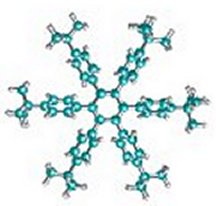A six-armed molecule is able to move groups of copper atoms from place to place

One of the first questions in chemistry classes is whether you can see atoms. The answer is no and yes. No, you can't see atoms with a normal microscope that focuses light and that allows you to see living cells, not even with an electron microscope - they're just too small. But there are devices that allow you to "see" atoms indirectly. These devices are called scanning tunneling microscopes (STM). The most important part of STM is a very sharp needle that scans the surface being tested and "senses" the atoms. Under certain conditions, the needle is even able to push a single atom and move it from place to place on the surface. But moving more than one atom at a time is a complicated operation. Therefore, the STM is not a convenient tool when you want to build a nanometer device, that is, a device several billionths of a meter in size, containing many atoms.
Recently, scientists from France and Germany advanced the technology one step further. They found a way to collect the atoms and move them from place to place in groups. Their work will allow them to perhaps, eventually, build and operate nanometric machines.
To do the job, the researchers created a new molecule with six arms, called by the long name hexa-t-butyl-hexa-phenyl-benzene (HB-HBP) [and for chemistry students: hexa, as you know, is six, t-butyl is a group of four carbons bound in the tertiary position, and phenyl is a benzene group - with the help of the image below it is easy to draw the molecule]. The molecule is built in a hexagonal shape of carbon rings supported by six groups that resemble the leg of a tripod. The molecule acts like a tiny vacuum cleaner, it moves easily over a surface made of copper and "sucks" loose copper atoms into it.
Experiments conducted at very low temperatures, and in airless conditions, showed that it is possible to move a molecule of HB-HBP carrying up to five assembled copper atoms. And how do you move it? The answer is simple - using an STM needle. Once the copper atoms have been placed in the desired location, the scientists can pick up the carrier molecule and leave the pack of atoms behind.
The scientists claim that this is an important step towards building molecular-sized machines. One day such tiny brooms will collect atoms and arrange them to form tiny electric wires. They will also be able to organize them in a way that will make it possible to control light, electricity or magnetic fields in new and useful ways.

Molecular Pacman: The special molecule (colored tower) collects copper atoms (gray dots) protruding from the surface of a copper surface (left to right). Then the molecule can release the charge elsewhere on the surface.
for further reading
